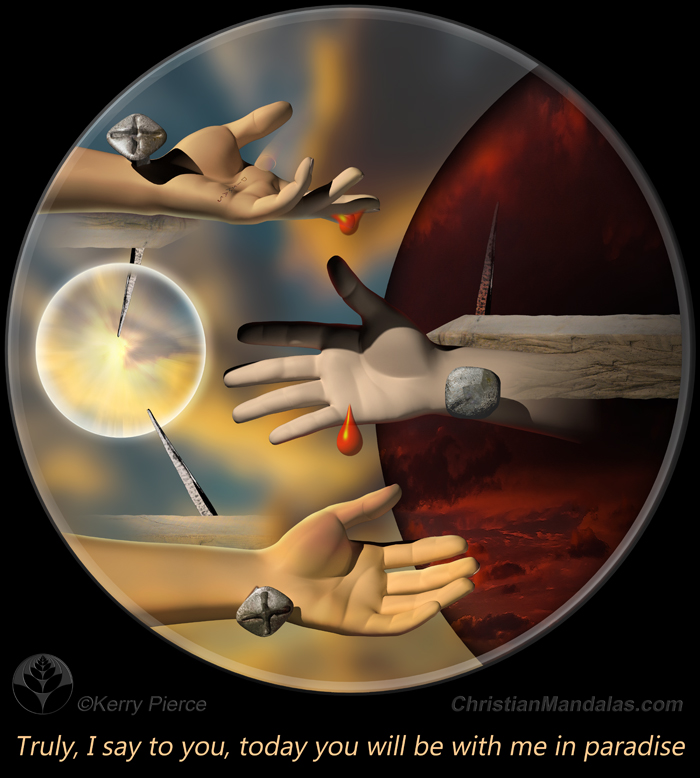
While there is life, there is hope.
The Penitent Thief is a Christian mandala I created over a long period while reflecting on the crucifixion passage in Luke 23. The focus of the image comes from verse 43 where Jesus tells the penitent thief on the cross next to him that he would be with our Lord in paradise that day.
The image is surreal, disorienting at first, but it entices us to ask questions and explore.
The lower hand is that of the penitent criminal in Luke 23. This criminal, crucified next to Jesus, is sometimes referred to as Dismas. The middle hand is that of the second thief crucified next to Jesus. Finally, the top hand is Jesus’.
Dismas was a criminal, a malefactor, a doer of evil. Sentenced to death, Dismas was at the bottom of the first-century Palestinian society.
On the cross, next to Jesus, something remarkable happened. Dismas confessed his sin and declared Jesus to be innocent. Next, he gave us the first direct expression of faith in the dying Messiah. This half-dead, corrupt man, surged forward in faith to rely on the grace of Christ.
This moment is summarized in the mandala with the drop of blood the fell from the hand of Christ. The second thief chooses to allow the blood of Christ pass him by. The believing, repentant Dismas reaches out to receive Christ’s blood.
Made clean by his faith in Christ’s work, Dismas joined Jesus in paradise.
Despite his background, Dismas believed in Jesus, and he was saved. Dismas, almost literally, made his decision for Christ at the last minute.
The Penitent Thief image is complex due to its surreal nature. Below is an excerpt from the book Surreal Christianity. Read on if you would like a brief introduction to Surrealism.
Space
“The image is a pure creation of the mind. It cannot be born from a comparison, but from two realities, more or less distant, brought together. The more the relation between the two realities is distant and accurate, the stronger the image will be—the more it will possess emotional power and poetic reality.”
These words, found in André Breton’s 1924 Surrealist Manifesto, come from the French poet Pierre Reverdy. Reverdy was a Christian.
Reading the quote, I immediately think of Jesus Christ. Jesus “…is the image of the invisible God…” Col 1:15 (ESV). True God and true man. Because of sin, these realities are distant. But in Jesus, these two realities are fully brought together. God and man brought together as an infant entering into our four dimensions of space and time. I hold this image of Christ in my mind; my understanding is reinforced and deepened by reading Scripture, by prayer, and through insights provided to me by the Holy Spirit.
As Reverdy predicts, the image of Christ that I hold in my mind sets up a powerful emotional, intellectual, and spiritual reality for me. The poetry and the mystery of Christ beg me to engage more deeply. I turn the image of Christ over in my mind, trying to visualize Him. Not surprisingly, this generates far more questions than answers.
But I need to know. I need answers. I want to explore this man with the Spirit of God who walked our earth. I press on, seeking guidance through Scripture, prayer, sermons, small group discussions, and art.
The answers come. They come unceasingly, during the day, and during the night. As I continue to wrestle with Christ, my mind is renewed. Christ spills over and is absorbed into my soul. My behavior changes as I am transformed.
This Jesus then becomes the most surreal concept I hold in my mind. He has captured my thoughts, my dreams, and my soul.
